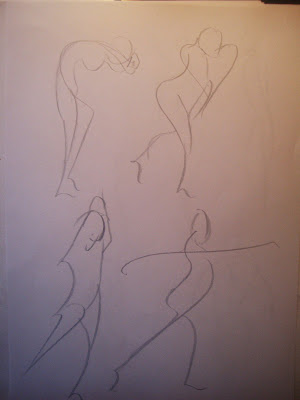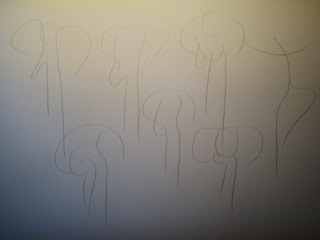30 Second Drawings:
These are some warm up sketches. I feel I can work faster and can deconstruct the pose quicker, picking up the essential elements.
15 Second Drawings:
I am still having trouble with my flow lines. I have trouble working at such speed especially when deciding what to draw and what to leave out. However I feel a slight improvement especially in the second page, the poses are clearer.
30 Second Arrow Drawing:
Here we went back to arrow lines. These I find an easier concept to grasps than the flow lines. Instead of keeping all the lines straight I allowed myself to curve them which I felt helped exaggerate the pose.
Left and Right Hand 1 Minute Drawings:
Here I first drew the pose with my left hand and then my right and was told to compare the two. Dan was instant that out Left hand drawing were better than our Right as they had more fluid lines. I disagree and think that the drawings are very disproportional and the lines are more static and broken than my Right hand drawings. When ever I draw I always keep my wrist off the table and use my shoulder keeping my lies fluid, which is why I think I like the Right hand drawings better.
Drawing A- left hand
Drawing A- right hand
Drawing B- Left hand
Drawing B- right hand
3 Minute Drawings:
Before drawing these posses we first wrote down descriptions of the pose, what they ment to us to help depict a particular characteristic when drawing. I found this did help but for me having more time to study the pose means I know what draw and how to draw it.
Description: protective, stationary, someone is about to jump over her (a ballet move).
Description: fluid, twisted, exploring space, about to push off into a spin.



















































